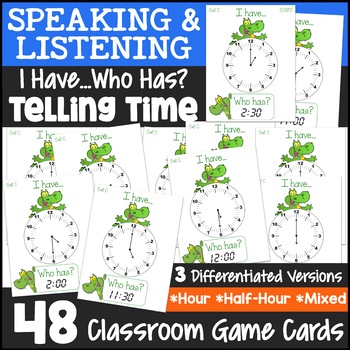Telling Time to the Hour and Half Hour I Have, Who Has Games (3 Sets)
Jason's Online Classroom
50.3k Followers
Grade Levels
K - 1st
Subjects
Resource Type
Standards
CCSS1.MD.B.3
CCSSSL.K.1a
CCSSMP1
Formats Included
- PDF
Pages
12 pages
Jason's Online Classroom
50.3k Followers
Also included in
- Telling Time Common Core Aligned I have... Who has? Games to help students learn telling time appropriately. Download Preview FileDownload the preview file for a sample view of the resource. Please ensure that it is appropriate for your grade level prior to purchasing.Set A - Telling time to the hPrice $4.00Original Price $7.00Save $3.00
- This telling time bundle contains our popular Telling Time Bingo, Telling Time "I Have...Who has?" Games and Telling Time Assessments all included in one package available at a lower price than purchasing individually. This bundle is primarily intended to align to Grade 1 Common Core Standards of tPrice $6.00Original Price $13.00Save $7.00
Description
Telling Time I have... Who has? Game to help students learn telling time appropriately.
Description
Set A - Telling time to the hour only (12 cards)
Set B - Telling time to the half-hour only (12 cards)
Set C - Telling time mixed hour and half-hour (24 cards)
Total game cards for sets A-C = 48
Telling Time Answer Keys Included
Total Pages
12 pages
Answer Key
Included
Teaching Duration
Lifelong tool
Last updated Jan 5th, 2013
Report this resource to TPT
Reported resources will be reviewed by our team. Report this resource to let us know if this resource violates TPT’s content guidelines.
Standards
to see state-specific standards (only available in the US).
CCSS1.MD.B.3
Tell and write time in hours and half-hours using analog and digital clocks.
CCSSSL.K.1a
Follow agreed-upon rules for discussions (e.g., listening to others and taking turns speaking about the topics and texts under discussion).
CCSSMP1
Make sense of problems and persevere in solving them. Mathematically proficient students start by explaining to themselves the meaning of a problem and looking for entry points to its solution. They analyze givens, constraints, relationships, and goals. They make conjectures about the form and meaning of the solution and plan a solution pathway rather than simply jumping into a solution attempt. They consider analogous problems, and try special cases and simpler forms of the original problem in order to gain insight into its solution. They monitor and evaluate their progress and change course if necessary. Older students might, depending on the context of the problem, transform algebraic expressions or change the viewing window on their graphing calculator to get the information they need. Mathematically proficient students can explain correspondences between equations, verbal descriptions, tables, and graphs or draw diagrams of important features and relationships, graph data, and search for regularity or trends. Younger students might rely on using concrete objects or pictures to help conceptualize and solve a problem. Mathematically proficient students check their answers to problems using a different method, and they continually ask themselves, "Does this make sense?" They can understand the approaches of others to solving complex problems and identify correspondences between different approaches.







